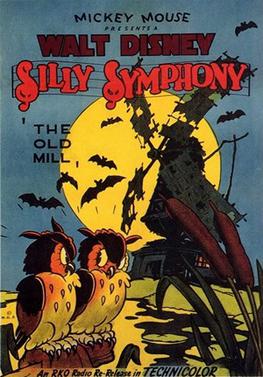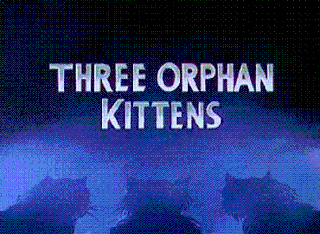
Snow White and the Seven Dwarfs is a 1937 American animated musical fantasy film produced by Walt Disney Productions and released by RKO Radio Pictures. Based on the 1812 German fairy tale by the Brothers Grimm, it is the first animated feature film produced in the United States and the first cel animated feature film. The production was supervised by David Hand, and the film's sequences were directed by Perce Pearce, William Cottrell, Larry Morey, Wilfred Jackson, and Ben Sharpsteen.
Silly Symphony is an American animated series of 75 musical short films produced by Walt Disney Productions from 1929 to 1939. As the series name implies, the Silly Symphonies were originally intended as whimsical accompaniments to pieces of music. As such, the films usually did not feature continuing characters, unlike the Mickey Mouse shorts produced by Disney at the same time. The series is notable for its innovation with Technicolor and the multiplane motion picture camera, as well as its introduction of the character Donald Duck making his first appearance in the Silly Symphony cartoon The Wise Little Hen in 1934. Seven shorts won the Academy Award for Best Animated Short Film.

The multiplane camera is a motion-picture camera that was used in the traditional animation process that moves a number of pieces of artwork past the camera at various speeds and at various distances from one another. This creates a sense of parallax or depth.
"Disney's Halloween Treat" is a 1982 Halloween-themed episode of Walt Disney which originally aired October 30, 1982 on CBS.

The Old Mill is a Silly Symphonies cartoon produced by Walt Disney Productions, directed by Wilfred Jackson, scored by Leigh Harline, and released theatrically to theatres by RKO Radio Pictures on November 5, 1937. The film depicts the natural community of animals populating an old abandoned windmill in the country, and how they deal with a severe summer thunderstorm that nearly destroys their habitat. It incorporates the song "One Day When We Were Young" from Johann Strauss II's operetta The Gypsy Baron.

Academy Award Review of Walt Disney Cartoons is an American animated package film released in the United States on May 19, 1937, for a limited time to help promote the upcoming release of Snow White and the Seven Dwarfs. It was a collection of five Oscar-winning Silly Symphonies shorts, bridged together with title cards and a narrator. Like The Many Adventures of Winnie the Pooh, each of the cartoons had been released on their own at first before being collected together as one film. The separate cartoon shorts are now available on DVD. In addition, the film is 41 minutes long, just like Saludos Amigos. However, while this film is fully animated, Saludos Amigos would be far shorter without the live-action sequences. It is considered the first film in the Walt Disney Pictures filmography.
One Hour in Wonderland is a 1950 television special made by Walt Disney Productions. It was first seen on Christmas Day, 1950, over NBC for Coca-Cola, and was Walt Disney's first television production. It featured Disney as host, with Bobby Driscoll, Kathryn Beaumont, Edgar Bergen & Charlie McCarthy, and other celebrities who worked with Disney, including the Firehouse Five Plus Two jazz band. This special was actually a promotional program for Disney's upcoming theatrical feature, Alice in Wonderland. Kathryn Beaumont, who voiced Alice, was dressed like her for this television special.
Persephone, the daughter of Zeus and Demeter in Greek mythology, appears in films, works of literature, and in popular culture, both as a goddess character and through the symbolic use of her name. She becomes the queen of the underworld through her abduction by Hades, the god of the underworld. The myth of her abduction represents her dual function as the as chthonic (underworld) and vegetation goddess: a personification of vegetation, which shoots forth in Spring and withdraws into the earth after harvest. Proserpina is the Roman equivalent.

Leslie James Clark was an American animator and the first of Disney's Nine Old Men, joining Walt Disney Productions in 1927.
Wilfred Jackson was an American animator, arranger, composer and director best known for his work on the Mickey Mouse and Silly Symphonies series of cartoons and the Night on Bald Mountain/Ave Maria segment of Fantasia from Walt Disney Productions. He was also instrumental in developing the system with which Disney added music and sound to Steamboat Willie, the first Mickey Mouse cartoon.
David Dodd Hand was an American animator and animation filmmaker known for his work at Walt Disney Productions. He worked on numerous Disney shorts during the 1930s and eventually became supervising director on the animated features Snow White and the Seven Dwarfs, Dumbo and Bambi.

William Norman Ferguson was an animator for Walt Disney Studios and a central contributor to the studio's stylistic development in the 1930s. He is most frequently noted for his contribution to the creation of Pluto, one of the studio's best-known and most enduring characters, and is the artist most closely associated with that character. He is also credited for developing Peg-Leg Pete and the Big Bad Wolf. Ferguson, known at the studio as "Norm" or "Fergy", was the primary animator of the witch in Snow White and the Seven Dwarfs, the first in a long line of great Disney feature villains. He was also a sequence director on the film.

Three Orphan Kittens is a 1935 animated short film in the Silly Symphonies series produced by Walt Disney Productions. It was the winner of the 1935 Oscar for Academy Award for Best Short Subject (Cartoons). It was followed in 1936 by a sequel, More Kittens.
Riley A. Thomson Jr. was an American animator and comics artist who spent most of his career working with Walt Disney films and characters. He directed six Disney short films including The Nifty Nineties and Symphony Hour.

Three Blind Mouseketeers is a Silly Symphonies cartoon based on the nursery rhyme Three Blind Mice and the 1844 novel The Three Musketeers by Alexandre Dumas. Directed by Dave Hand and Jack Cutting, it stars Billy Bletcher.
Merbabies is a Silly Symphonies animated Disney short film. It was released on December 9, 1938. It is a collaboration between Walt Disney and Harman and Ising, the latter studio having donated artists to Disney to work on the production of Snow White and the Seven Dwarfs (1937). It is one of the last shorts of the Silly Symphonies series.
Claude Coats was an American artist, background artist, animator and set designer, known for his work with the Walt Disney Animation Studios and Walt Disney Imagineering. His pioneering work with the company helped define the character of animated films, and later, immersive installations with his designs for Disneyland. Coats, known as "The Gentle Giant" was inducted a Disney Legend in 1991.
Snow White is a Disney media franchise that began in 1937 with the theatrical release of Snow White and the Seven Dwarfs. It is based on the 1812 fairy tale by the Brothers Grimm.

The Haunted House, also known as Haunted House, is a 1929 Mickey Mouse short animated film released by Celebrity Productions, as part of the Mickey Mouse film series. The cartoon was produced by Walt Disney Productions and distributed by Celebrity Productions. It was the fourteenth Mickey Mouse short to be produced, the eleventh of that year.
Silly Symphony is a weekly Disney comic strip that debuted on January 10, 1932, as a topper for the Mickey Mouse strip's Sunday page. The strip featured adaptations of Walt Disney's popular short film series, Silly Symphony, which released 75 cartoons from 1929 to 1939, as well as other cartoons and animated films. The comic strip outlived its parent series by six years, ending on October 7, 1945.









